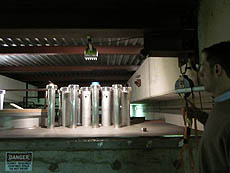Getting LBNE 35-ton cryostat ready for cool-down
 |
David Montanari stands by the LBNE 35-ton cryostat. Photo: Anne Heavey
|
A 35-ton-capacity cryostat—a prototype for the proposed multi-kiloton LBNE liquid-argon far detector—stands ready for cool-down in PPD's PC-4 facility and for its first liquid-argon fill.
Workers constructed the garage-sized cryostat by welding together modular, multi-layer pieces to form a single insulated and leak-tight "membrane" similar to that planned for the LBNE far detector. Testing will begin this summer to determine whether the liquid-argon purity levels required by LBNE can be achieved and kept stable in this type of cryostat without prior evacuation. The liquid-argon purity demonstrator (LAPD), a cryostat of smaller size and different construction, reached these goals in 2012, paving the way for this LBNE prototype.
Purer liquid argon makes for cleaner detector signals, since impurities tend to "capture" electrons ionized by particle interactions—the very electrons the scientists want to detect—before they reach their destination.
Discarded practice welds for the inner stainless steel membrane and various glued insulation samples outside the cryostat reveal the complex, layered construction performed by the cryostat team, led by engineer David Montanari. A dozen or so penetrations emerge from the top of the tank for the cryogenic services that will now be deployed—the fill system, purity monitors, condenser, purification system lines, temperature sensors and safety devices—the same systems that LAPD has been using.
Engineer Terry Tope coordinates the extension of these systems to the LBNE prototype. Several switches and two critical valves, installed last year while LAPD was undergoing repairs and upgrades, will enable switching the entire system from servicing one tank to the other.
Currently Tope's team is finishing the piping hookup from the purification systems to the 35-ton cryostat and the controls work. The next step will be to purge the cryostat of air using gaseous argon, after which a mix of liquid and gaseous argon will be sprayed into the cryostat to cool the volume down to about -298 degrees Fahrenheit. At this point, the liquid from LAPD will be introduced and circulated through filters until a high purity is achieved.
If anything goes wrong during the fill, the liquid argon—worth about $30,000, according to Tope—won't be lost. It can be pumped back to LAPD while the team fixes the problem.
Once the liquid has been successfully transferred, additional liquid argon from DZero will be brought in to top off the 35-ton cryostat. Then the purity testing, coordinated by physicist Alan Hahn, will begin. Maintaining the purity level over the run is an important goal.
"We plan to adopt the same data-taking scheme that LAPD is using—every two hours we run the purity monitors and record the data," Hahn said. "This fits the time scale of purity changes, usually on the scale of a day."
The prototype is expected to provide results in about three months of running.
—Anne Heavey
|